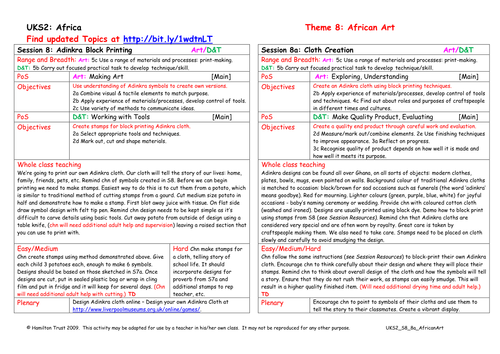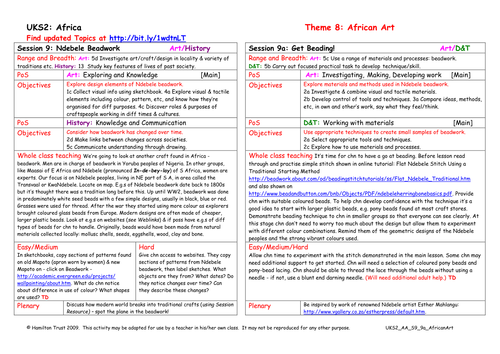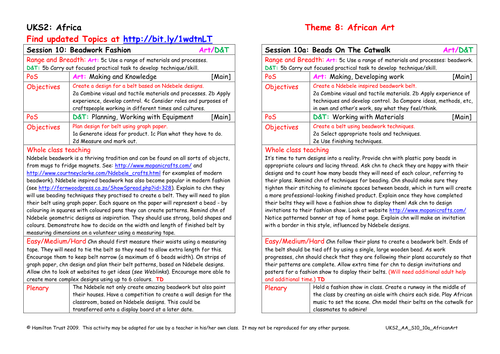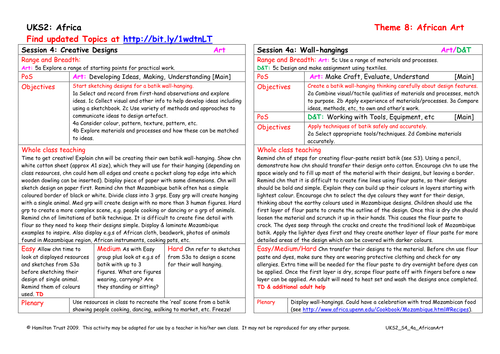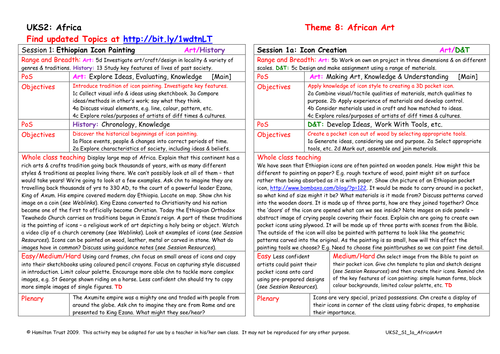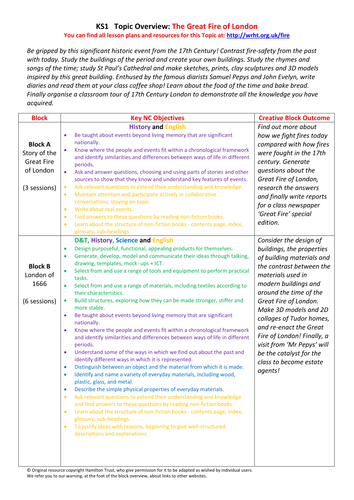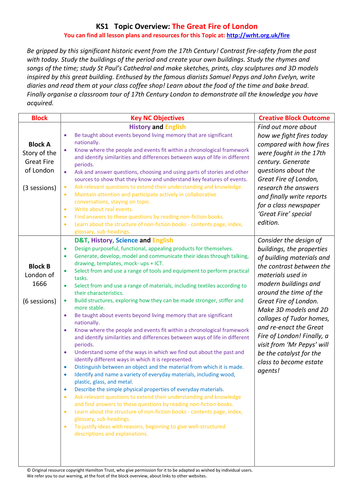
3k+Uploads
10010k+Views
11618k+Downloads
Design, engineering and technology

Cloth Creation
Inspired by the Adinkra cloths worn on special occasions all over Ghana, children create their own versions. Children think carefully about overall design of their cloth and how they will block print using stamps.

Get Beading!
Time to have a go at beading! The traditional Ndebele methods of beading are demonstrated and children have a chance to experiment with this new technique.

Beadwork Fashion
Ndebele beadwork is a thriving tradition and can be found on all sorts of modern items. Children explore how it has been used in fashion and design simple belts based on the geometric designs of the Ndebele people

Wall hangings
Using the techniques of flour resist batik, children create wall hangings in the style of the Mozambique batik they have studied.
Children are encouraged to carefully select techniques and tools to create a quality product.

Icon Creation
Create an Ethiopian pocket icon. Children explore techniques of painting on wood and create their own icon images based on their studies.

Energy
This session we consider how we are using up fossil fuels. How did we heat our homes and cook in the past? Discuss renewable energy and any local schemes to try and use more renewable energy. Challenge children to make a solar oven and cook something with it!

Weigh it up
In this busy session, children learn about shops and what it was like to shop for food in the past. They use scales to measure out ingredients, make shopping lists and bake cakes!
Suitable for years 1 and 2.
Find other lesson plans and resources at www.hamilton-trust.org.uk.

Dinosaurs and Fossils - Fossils and Rocks - Upper Key Stage 2
Be a palaeontologist! Excavate a fossil block and research the three main epochs of fossils. Find out how fossils are made and make your own. Tour your school sharing your knowledge with other children.
Includes:
- Topic Overview
- Block Overview
- Lesson 01: Being palaeontologists
Try your hand at being a palaeontologist by excavating a fossil block, generating questions about fossils and starting a dino-dictionary.
- Lesson 02: Fossils and the Timeline
Develop your palaeontologist expertise; research the three main epochs of fossils and put them on a timeline.
- Lesson 03: How are fossils formed?
Find out how fossils were made and make your own clay mould fossil, an ‘amber’ resin fossil and your own Dino-poo fossil.
- Lesson 04: Visit to a Natural History Museum
Experience fossils at first hand in a Natural History Museum; study them in detail and make drawings.
- Lesson 05: Palaeontologists on tour
Share your palaeontologist expertise with other children by taking your learning on tour.
Find more lesson plans and resources at www. hamilton-trust.org.uk.

The Great Fire of London - Visit 17th Century London - Key Stage 1
Be gripped by this significant historic event from the 17th Century!
Prepare tours for key London places, make souvenirs, role-play key people and draw maps, ready to transform your classroom into a recreation of 17th Century London at the time of the 1666 Great Fire. Become tour guides and teach visitors about this historic event.
Includes:
- Topic Overview
- Block Overview
- Lesson 01: The Great Fire of London Tour
Prepare a tour guide speech to inform visitors to 17th Century London about the key places that were involved in the Great Fire.
- Lesson 02: The Great Fire of London Souvenirs
Design and create Great Fire of London souvenirs, using your knowledge of the event.
- Lesson 03: Table top maps
Create informative tabletop maps of 17th Century London, using your knowledge of the event and your imagination.
- Lesson 04: Guided tours of 17th century London
Using all you have learned about the Great Fire of London, turn your classroom into a recreation of 17th Century London. Guide visitors around key places of the time, tell them about this historic event and then invite them to choose a souvenir.
Find more lesson plans and resources at www. hamilton-trust.org.uk.

Roman Buildings and Engineering
What buildings did the Romans build and for what purposes? How did they solve practical engineering problems such as providing enough water for their towns and cities, and enabling the army to get from A to B. Children study Roman roads, buildings and aqueducts. They build models, carry out scientific tests and make a presentation of all they have found out.
Includes:
- Topic Overview
- Block Overview
- Lesson 01: Roman architecture
Children study the types and architecture of Roman buildings, including the use of columns, pediments, colonnades, etc. They make a model Roman building.
- Lesson 02: Testing the strength of columns
Continuing to look at aspects of Roman architectural style, children consider the varieties of 3D shape which can be used to hold up the weight of a roof and further stories. They conduct a fair scientific test.
- Lesson 03: Roman arches
Why did the Romans use so many arches? Children conduct an investigation on effectiveness of different shaped arches by manipulating length of span and measuring height and load bearing strength.
- Lesson 04: Roman roads
Children learn how Roman roads were made and where they were built. They place Roman towns and cities on a map of Britain.
- Lesson 05: Roman aqueducts
Understanding how the Romans carried water using aqueducts, children begin to make a cardboard model aqueduct.
- Lesson 06: Finishing the model aqueduct
Children complete their model aqueduct and prepare and present information on Roman architecture.
Hamilton’s cross-curricular topics provide extensive planning resources to facilitate teaching a range of subjects under specific historical, geographic or thematic umbrellas.

The Great Fire of London - London of 1666 - Key Stage 1
Be gripped by this significant historic event from the 17th Century!
Consider the design of buildings, the properties of building materials and the contrast between the materials used in modern buildings and around the time of the Great Fire of London. Make 3D models and 2D collages of Tudor homes, and re-enact the Great Fire of London! Finally, a visit from ‘Mr Pepys’ will be the catalyst for the class to become Stuart estate agents!
Includes:
- Topic Overview
- Block Overview
- Lesson 01: Fantasy buildings & Resource
Discuss the properties of ideal buildings, including function and materials (this is an ideal opportunity to plan a visit from an Architect).
- Lesson 02: Building materials
Learn about the properties of materials used in modern building construction, including around the exterior of the school.
- Lesson 03: Builders then and now (part 1)
Compare and contrast building materials available today and 450 years ago using research and practical tasks.
- Lesson 04: Builders then and now (part 2)
Evaluate the stability of Tudor buildings by creating 3D models, 2D collages and labelled diagrams and making wattle and daub.
- Lesson 05: London's burning!
Create a model Tudor street and consider the effects of it burning down.
- Lesson 06: Estate Agents
Write Tudor property descriptions, using historical knowledge, and present them in role to ‘Mr Pepys’.
Find more lesson plans and resources at www. hamilton-trust.org.uk.

The Great Fire of London - Bakery - Key Stage 1
Be gripped by this significant historic event from the 17th Century!
Learn about the food eaten at the time and contrast the diet of the rich and poor. Compare and contrast contemporary and period recipes and produce them for the end of topic exhibition. Study the Great Fire monument in London and build your own structure to symbolize this historic event.
Includes:
- Topic Overview
- Block Overview
- Lesson 01: Banquets and Picnics
Children can choose to be either ‘Royalty’ or ‘Peasants’ to compare and contrast the food we eat today with the food available in Tudor and Stuart times.
- Lesson 02: Bakers!
Children will bake two different types of bread, taste, compare and contrast them and decide which one should be produced for the end of topic exhibition. Children will also design and build a model structure to symbolize the importance of the Great Fire of London.
Find more lesson plans and resources at www. hamilton-trust.org.uk.

Dinosaurs and Fossils - Dinosaur DIY - Upper Key Stage 2
Be a palaeontologist! Research key features of dinosaurs and how they are adapted to their environment; design your own dinosaur perfectly adapted to either the Triassic, Jurassic or Cretaceous period; create the structure, cover and paint your dinosaur model; finally, contribute to an ‘I Spy Dinosaurs’ class book and share your knowledge with other children.
Includes:
- Topic Overview
- Block Overview
- Lesson 01: Dino DIY - planning
Research key features of dinosaurs and then design a dinosaur perfectly adapted to either the Triassic, Jurassic or Cretaceous period.
- Lesson 02: Dino DIY - making
Working from a design plan, create the structure of your dinosaur.
- Lesson 03: Dino DIY - painting
Research skin colours and textures of modern living things and apply your knowledge to create the most suitable surface for your dinosaur model.
- Lesson 04: 'I spy' a DIY Dino
Contribute to a class ‘ I Spy’ dinosaur book with photographs, list of characteristics and possible ‘footprints’.
Find more lesson plans and resources at www. hamilton-trust.org.uk.

